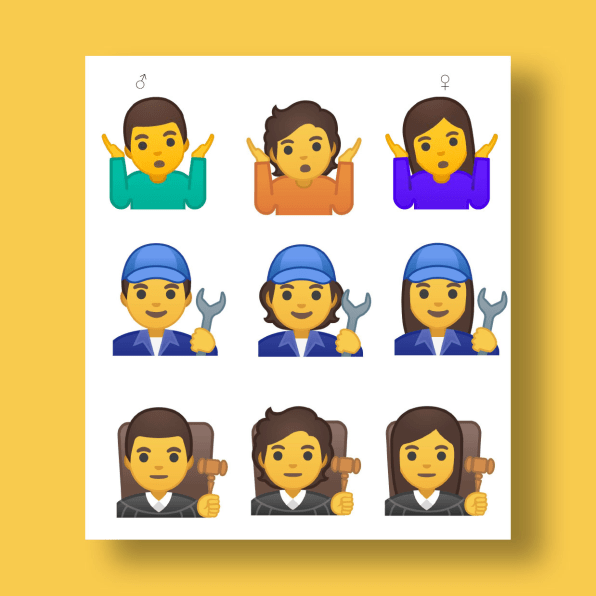All images: Google
Emojis are important. They colour conversations, stand in for your speechlessness and diffuse the tension when you make a loaded statement. And while the icons have gotten a major overhaul from the 176 that were originally released back in 1999 to more than 3,000 today, the evolution of the emoji species continues with Google’s newest release of over 50 gender-fluid emojis.While the OG emojis went from being yellow, like they were straight outta Simpsons, to embracing a range of colours, major changes were made to skin tones and sexual orientation. So while we now have same-sex couples and dark-skinned praying (or high-five?) signs, nothing related to gender really saw much change.But as more and more people feel the need to declare their gender identity on their Instagram or Twitter bio, androgyny takes over trends and people open up to the idea of gender fluidity, it’s the world’s attitude towards gender that is changing.In keeping with this growing sense of awareness around gender ambiguity, Google is attempting to make its emojis inclusive yet universal. And this inclusivity expands to even include gender-fluid zombies and merpeople, opting to shade them in gender-neutral colours instead of the traditional pink or blue.According to Jennifer Daniel, designer at Google, the age-old issue of identifying gender in visual language all started with the male bathroom symbol. “That person could be man, woman, anyone,” she told Fast Company. “But they had to add a little detail, that dress, and suddenly that person symbol doesn’t mean person anymore; it means man. And that culture means a man-centered culture.”In an attempt to change this, Google has worked on identifiable features for emojis that glide across the gender spectrum and try to be somewhere between male and female. The idea is to create emojis that break free from the binary and don’t conform to stereotypical gender roles such as male construction workers or female dancers.It boils down to the tiniest of details: The vampires are given a chain instead of a bowtie or necklace, and the merperson has an orange tail and their arms crossed instead of wearing a bra or being bare-chested. Even with hair (which is everything, according to Fleabag), the designers chose to go with a parted hairstyle that has a bit of length at the back and curls in a casual manner. “Gender is complicated,” continues Daniel. "It is an impossible task to communicate gender in a single image. It’s a construct. It lives dynamically on a spectrum. I personally don’t believe there is one visual design solution at all, but I do believe to avoid it is the wrong approach here. We can’t avoid race, gender, any other number of things in culture and class. You have to stare it in the face in order to understand it. That’s what we’re trying to do–to [find] the signifiers that make something feel either male or female, or both male and female.”
“Gender is complicated,” continues Daniel. "It is an impossible task to communicate gender in a single image. It’s a construct. It lives dynamically on a spectrum. I personally don’t believe there is one visual design solution at all, but I do believe to avoid it is the wrong approach here. We can’t avoid race, gender, any other number of things in culture and class. You have to stare it in the face in order to understand it. That’s what we’re trying to do–to [find] the signifiers that make something feel either male or female, or both male and female.” Google’s newest rainbow run of emojis will be rolled out on Pixel phones in beta this week, and all Android Q phones later this year. But even as this attempt of inclusivity takes its baby steps, the issue is that these emojis will bounce back to binary gender roles when sent to Apple or Samsung users. And TBH, most people would rather use emojis reflected on smiley faces, which don’t assign any specific gender and communicate the most minimal human detail without getting into complex concepts of gender.So while it’s an attempt to appreciate, even Google is aware that it may take a while to become a common practice. But even as Google is working on dialling back to basic stick symbols, at least we’re inching ahead on the rainbow scale and accepting that gender should just go with the flow.Follow Shamani Joshi on Instagram.
Google’s newest rainbow run of emojis will be rolled out on Pixel phones in beta this week, and all Android Q phones later this year. But even as this attempt of inclusivity takes its baby steps, the issue is that these emojis will bounce back to binary gender roles when sent to Apple or Samsung users. And TBH, most people would rather use emojis reflected on smiley faces, which don’t assign any specific gender and communicate the most minimal human detail without getting into complex concepts of gender.So while it’s an attempt to appreciate, even Google is aware that it may take a while to become a common practice. But even as Google is working on dialling back to basic stick symbols, at least we’re inching ahead on the rainbow scale and accepting that gender should just go with the flow.Follow Shamani Joshi on Instagram.
Advertisement
Advertisement


